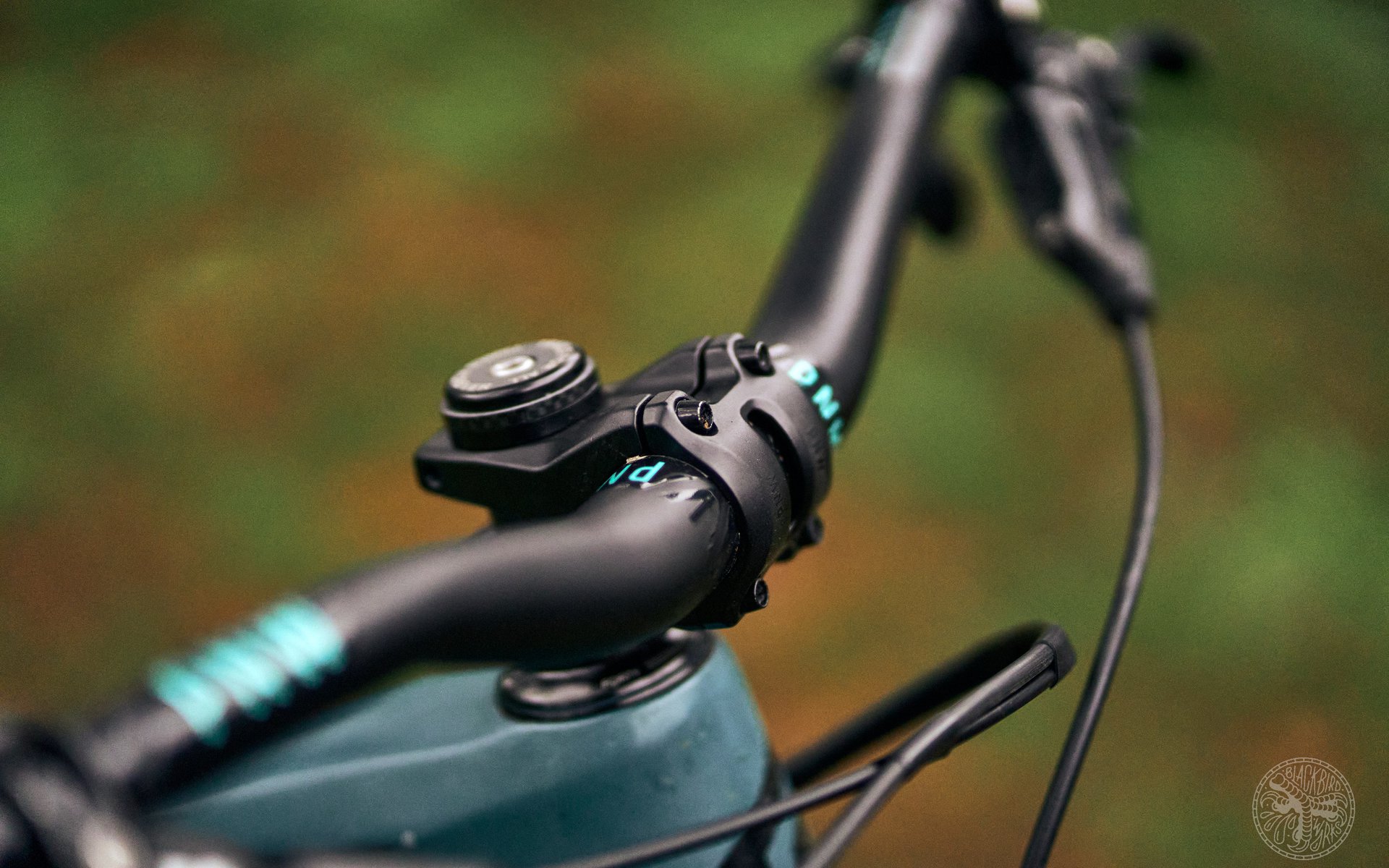
REVIEW
PNW Components Range Gen 3 Bar and Stem
There's only so many words to say about a handlebar (the PNW Range Gen 3 does have a couple nice points we'll get into later) but unless you're into the world of big sweep or extra wide about the only real things to comment on are stiffness and compliance. So before we get that out of the way, let's have a quick chat about your handlebar. Do you know how old your handlebar is? Are you sure you haven't over torqued your control clamps, or scored the bars with them? What about that scratch; how deep is it?
If you've never had a handlebar fail catastrophically mid-ride, I'd bet a lot of these questions seem silly to you. I'd also bet there's a few Tales of Woe that show up in the comments. If you've ever broken a bar, that's your cue; tell us the story below, assuming you lived to tell it. My story is from the mid-00s. during my stint working as a high school grom at the greatest bikeshop (and bar?) the world has ever known, laps of Teton Pass were a daily occurence, especially on Sunday when the shop closed early so we could all knock off and go ride. This was the early days of Teton Pass freeride; no rules, lots of Kona Stinkys and Stabs, and onions on our belts (it was the style at the time). The day's lap on Unmedicated Ritalin Monkey (named after the builder) included sessioning a large log ride to drop known as Snuffleupagus. To keep this under 1,000 words, the right side of my bar snapped off at the stem on landing. Through some combination of luck and limited skill I managed to only lightly smash myself into the ground.

The PNW Components Range Gen 3 handlebar in flight (Photo: Deniz Merdano)
For the twenty odd years between then and now, I've maintained a strong aversion to ever breaking a bar again. I replace my bars regularly, every 12-18 months. I'm careful with torque for stems and control clamps. I check for scoring under the clamps (anecdotally, most of the breaks from other people I've seen have been here). And, if I crash and scratch a bar, I replace it. Which brings us back to the PNW Components Range Gen 3 handlebar.
Highlights
| -- | Range Handlebar Gen 3 | Range Stem Gen 3 | The Coast Stem |
|---|---|---|---|
| Price (USD) | 69 | 79 | 69 |
| Clamp Diameter (mm) | 31.8, 35 | 31.8, 35 | 31.8 |
| Width or Length (mm) | 800 (tested at 780) | 40, 50 | 60, 70, 80, 90, 100 |
| Weight (g) | 31.8mm/314, 35mm/310 | 148 - 170 | 111 - 136 |
| Material | 2014-T73 heat treated alloy | 6061 aluminum alloy | -- |
| Other | 10 deg backsweep, 5 deg upsweep | GoPro/Accessory Mount | GoPro/Accessory Mount |
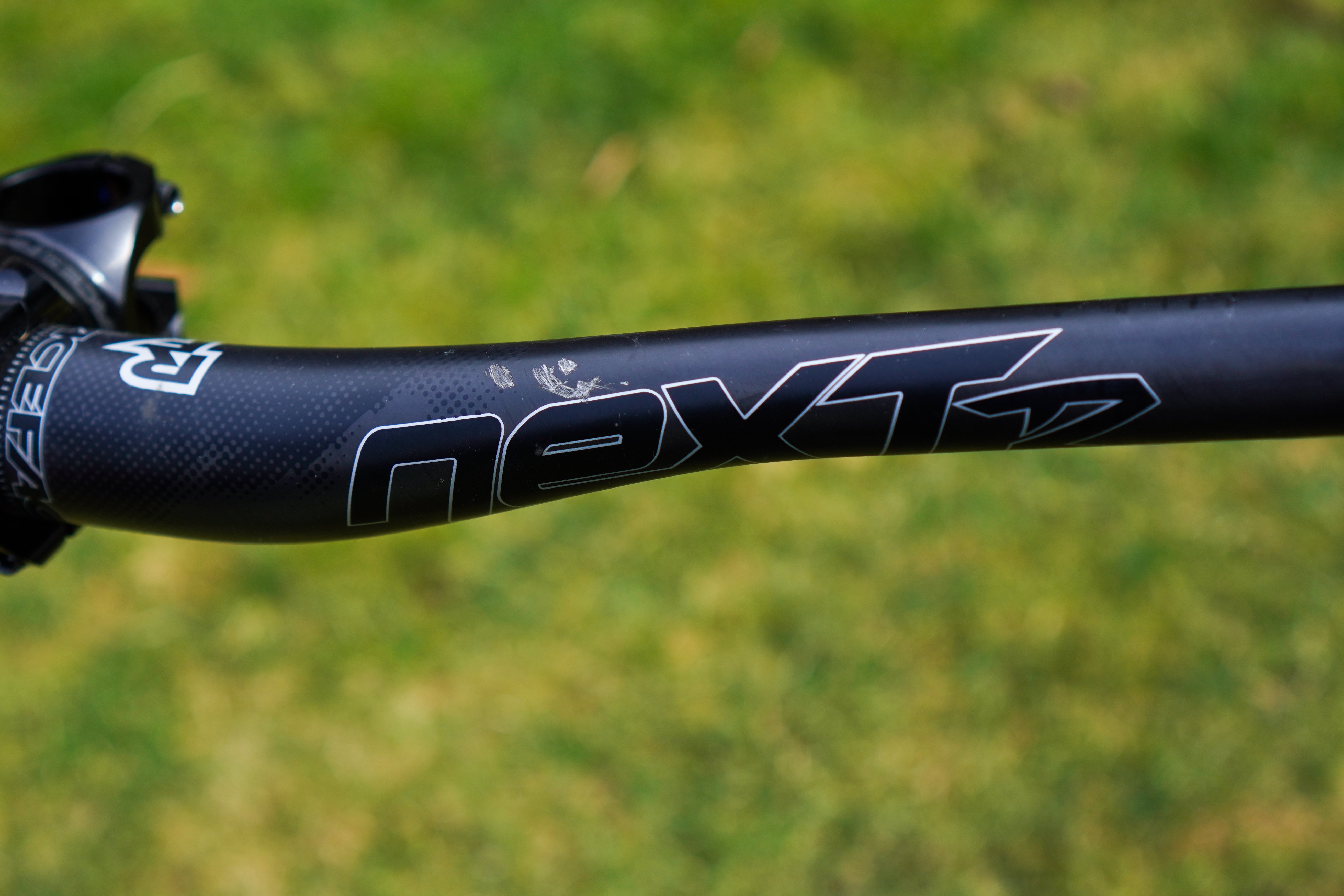
This RaceFace NextR handlebar has been retired, due to these scratches. Necessary? I don't know, but I don't need the risk in my life. (Photo: Cooper Quinn)
I received the Range Handlebar and Stem, cut the bar down to my preferred 780mm width, installed both onto the Transition Spur, chucked everything on the back of the truck, and off we went to Vancouver Island for a weekend. Whereby after doing all the hard parts (pedaling to the top) after about 9 seconds of descending I proceeded fold the front end, go OTB, and smash myself all over sharp pointy rocks. In the process I torqued a shoulder up, put a disconcertingly deep scratch in the bars, right between the MMX clamp and grip, and a couple decent dings in the Spur. F!#$%.
The scratch probably wouldn't cause a failure. But, there's two components to hazard assessment; risk and consequence. While the risk of this bar breaking was relatively low, the consequences can be high, and its not a game I play after Snuffleupagus tried to take me. I sheepishly emailed PNW, explained I'm an idiot, and they graciously sent a fresh handlebar.

Sequence of events. Hey! We're at the top! ... F(*&ing ouch. That hurt. There's no photo of the crash site, as I dragged all the pieces of my bike and pride back together and limped home for dinner. (Photo: Cooper Quinn)
Installation
There's only so much you can say about installation of a stem and handlebar, but there are a few differentiating features that I look for. Having the stem machined such that one half of the faceplace closes completely save attempting to torque four bolts down in unison. Well registered marks on the handlebar for centering and roll alignment are also critical, there's cut lines if you prefer narrower bars, and some markings around the control attachment points to keep things symmetrical without a measuring device. Everything comes in nice recyclable boxes
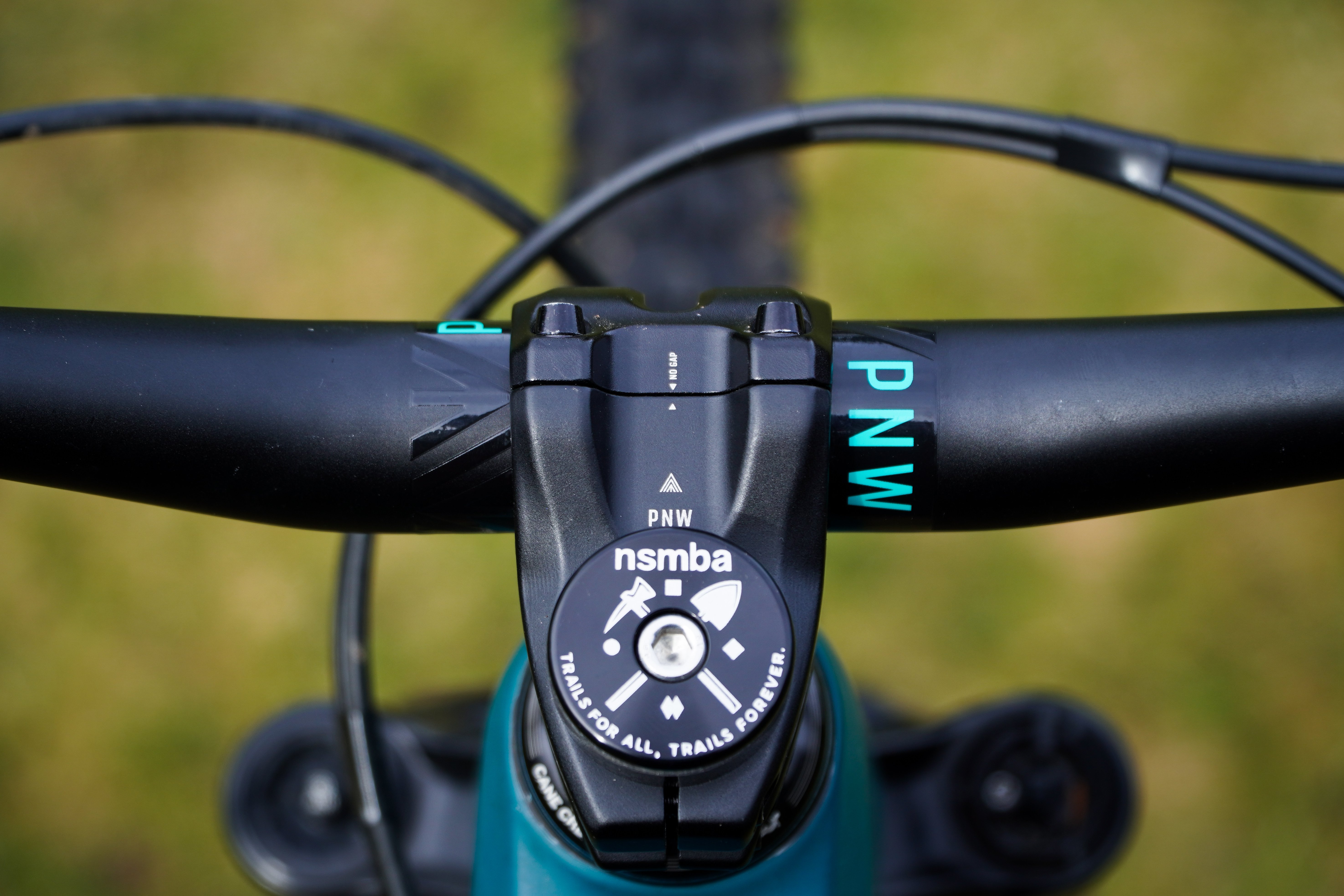
Mind the gap. (Photo: Cooper Quinn)
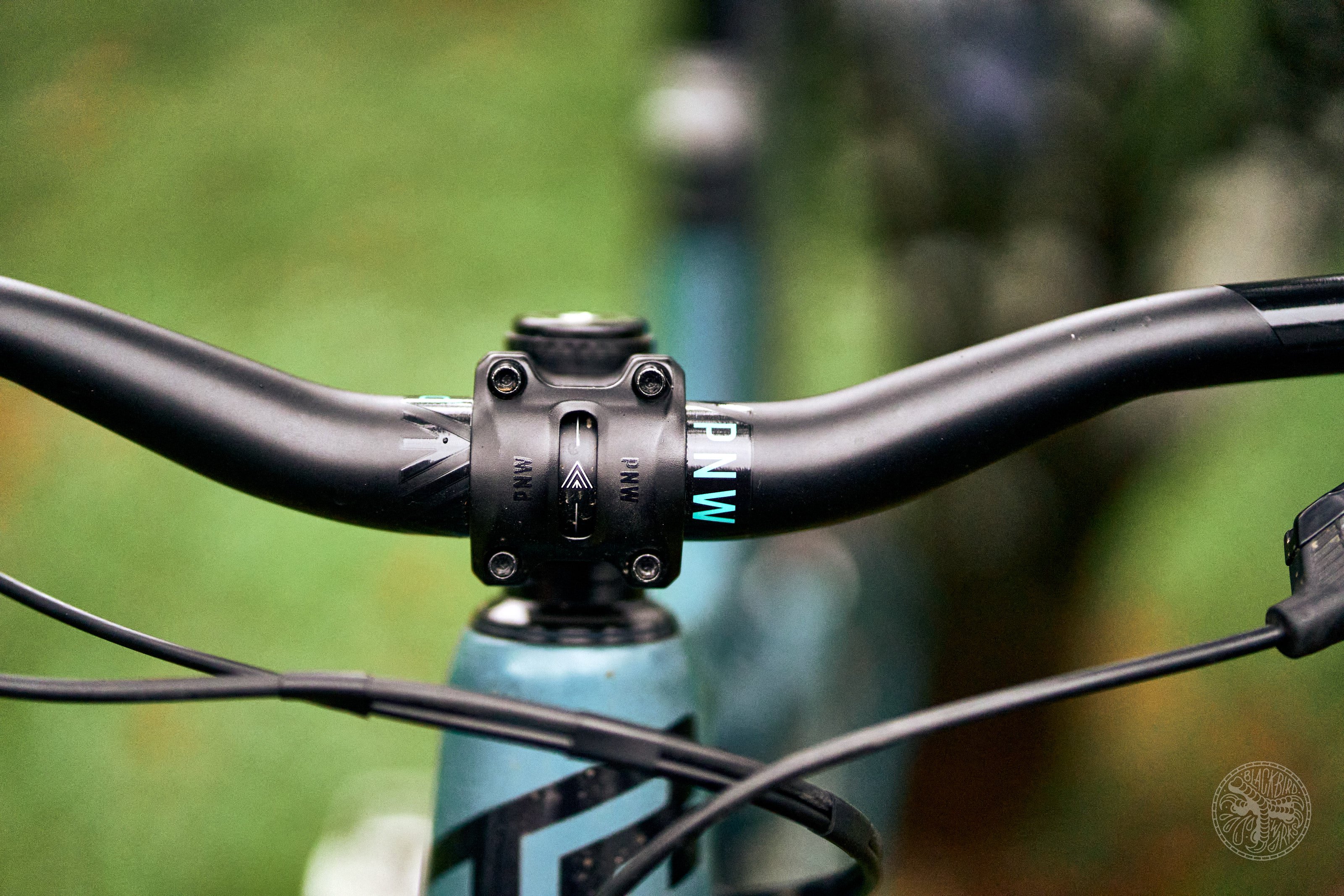
Easy to center. (Photo: Deniz Merdano)

60mm Coast XC/Gravel stem with accessory mount - the mount is included with all PNW stems, but easily removable prior to installation. (Photo: Deniz Merdano)
Riding Impressions
After a touch of adapting to the higher rise (+10mm) of the previous OneUp bars, I settled into the Range cockpit nicely. It's not a particularly flexy bar, but they do a good job of muting trail chatter; a very useful feature when mounted to a shorter travel machine like Transition's Spur. The upsweep and backsweep suit me just fine. Finding a comfortable roll position was a matter of one on-trail adjustment (I'm also not super fussy here). Once roll was settled, I just rode. And rode some more. And in the best way, the cockpit just faded into the background and became part of the bike, neither too flexy nor too stiff.
I haven't been able to take advantage of the accessory mount on my mountain bikes, but I do think it's a clever bonus feature for lighting. Keep an eye out here for that Coast stem to make an appearance at some point - with lights!
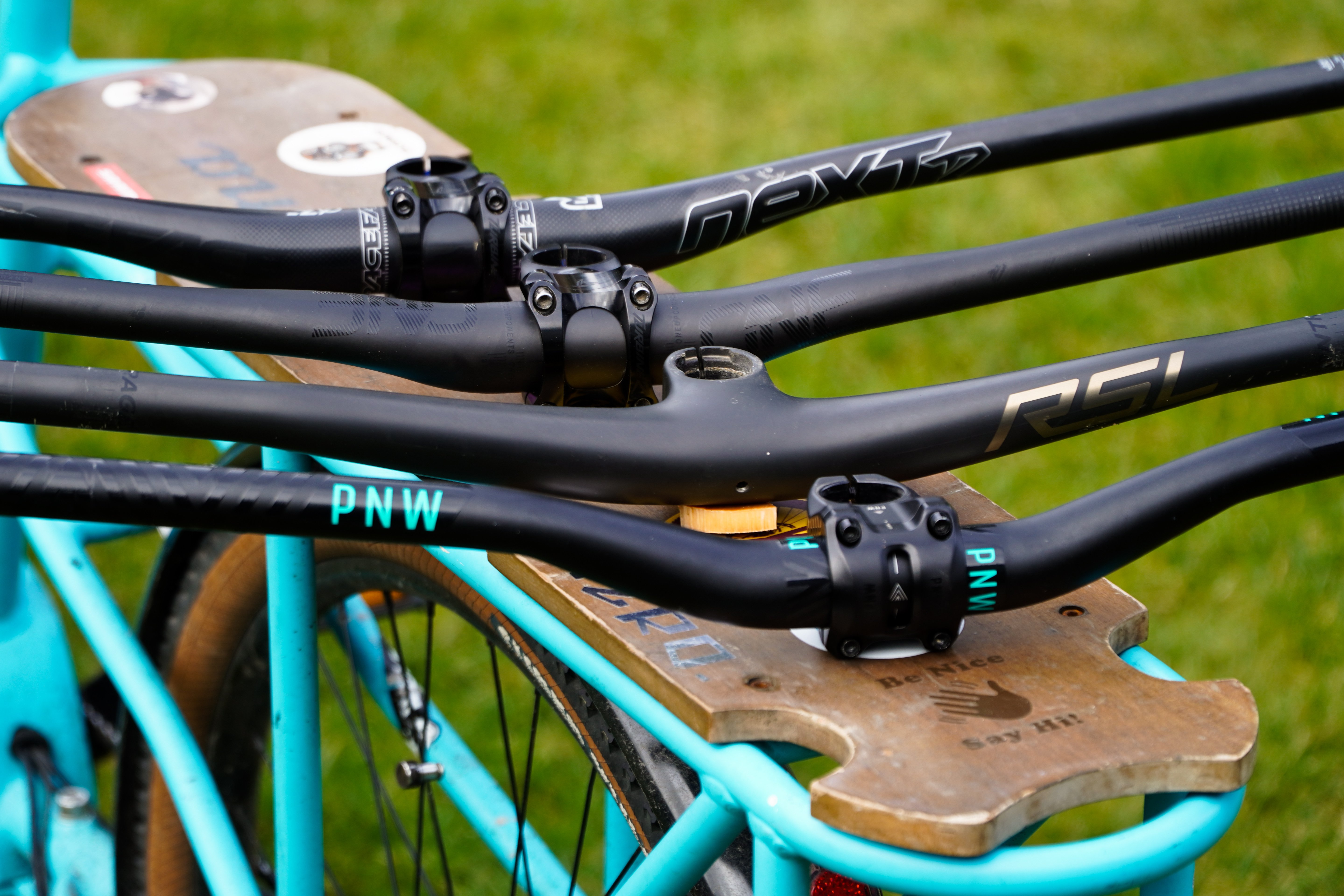
There's a lot of cockpit options out there, from the US$69 + US$79 PNW Range Gen 3 to the US$366 Bontrager RSL. On my personal bikes I run a OneUp bar (US$150) with RaceFace TurbineR stem (US$109). The NextR bar in the back I find way too stiff, but could be a good option for heavier riders. (Photo: Cooper Quinn)
Conclusion
If you're looking for affordable cockpit options, be it a replacement for an aged handlebar, a solid no-fuss stem with some nice features, a case of upgradeitits, or all of the above, the PNW Range...uh... range... would be on my list. There's a few diameter and length options, and as long as you like 30mm rise, you should be able to find a colour that suits your bike nicely. Sure there are lighter and fancier options, but do you need them? PNW Components is a company that cares about their products, consumers, and the environment; always friendly, and I've heard nothing but good experiences from regular folks running the product, or dealing with ordinary customer service concerns. If you're in the market for a dropper and on a budget, keep an eye on thePNW Cycled section of the website where lightly used but returned products are checked over and sold through the website.
The handlebar is available here, and the stem is here, and if you need any additional deciding factors... they're in stock!
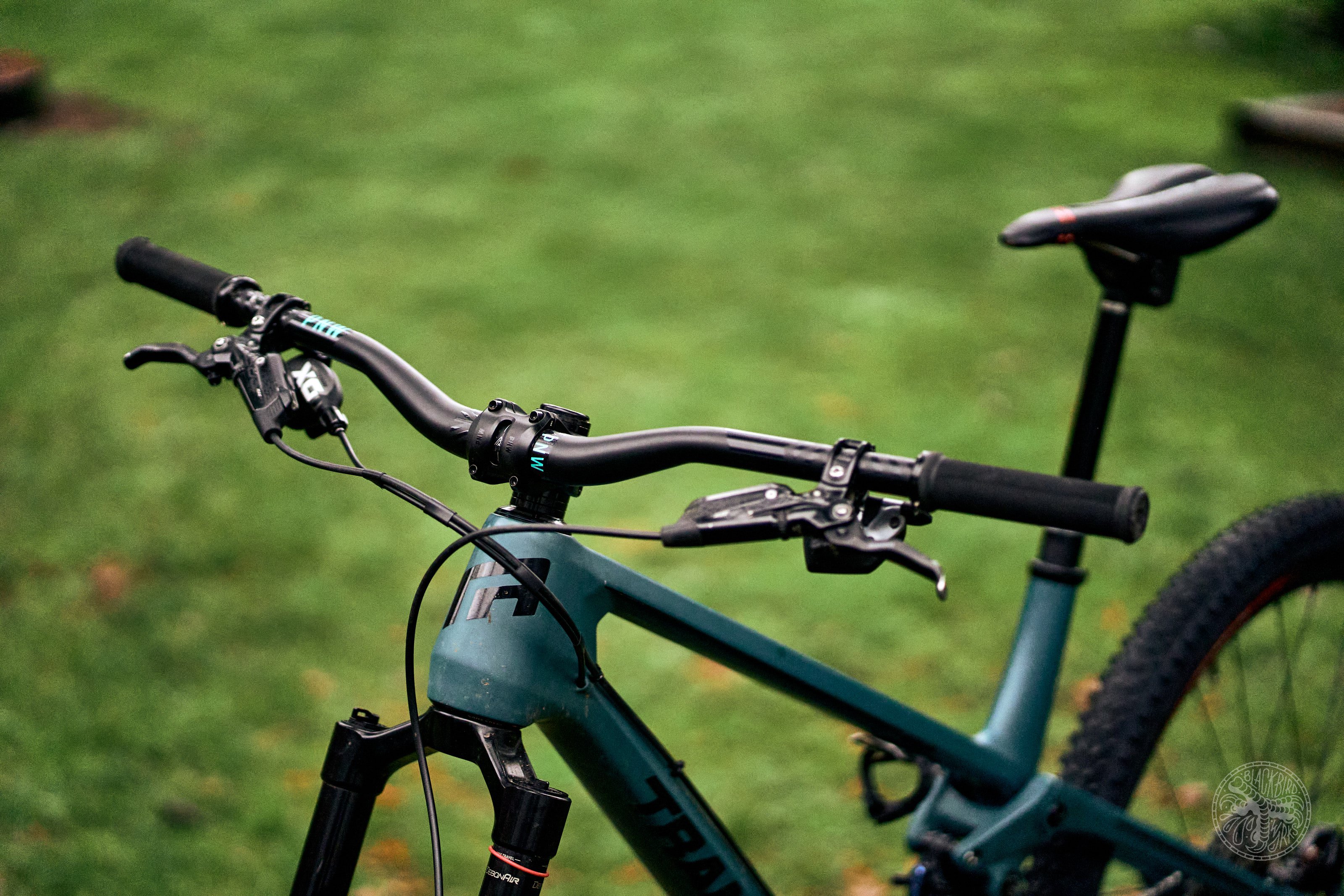


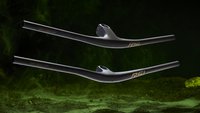



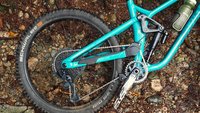

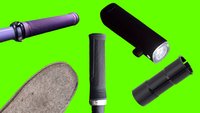


Comments
Dave Tolnai
1 year, 10 months ago
On Recycling...anybody that lives in Metro Vancouver has no excuse to not recycle metal bicycles and bicycle parts. It's really only down to laziness if you're not doing it.
Working Bike Parts
Our Community Bikes! If you have any part that would fit on a bicycle that is still functional, take it there. Similarly, if you have an old bike and you need something to keep it running, go there. You might stumble upon some fascinating stuff.
https://ourcommunitybikes.org/
Vancouver - Metal Bicycles and Parts
Super easy in Vancouver. Take your old bicycle, working or not, and any scrap metal bike parts to the Zero Waste Center. Anything not working, throw it in the giant scrap metal bin and it will get recycled. Steel, aluminum, whatever. If it has some plastic on it, no biggie. The extra bonus here is that they have a program where they set anything close to a working bicycle aside for Our Community Bikes. If you see something cool attached to any of those bicycles...do not attempt to unbolt it yourself. Lesson learned from an attempted liberation of a sweet Brooks saddle that I spotted there one day.
https://vancouver.ca/home-property-development/zero-waste-centre.aspx
Metro Vancouver - Metal Bicycles and Parts
Metro Vancouver has several recycling depots across the region. I'm less familiar with their exact set-up, but they will take scrap metal. So worst case, your old metal bicycle will be recycled.
http://www.metrovancouver.org/services/solid-waste/garbage-recycling/transfer-stations/Pages/default.aspx
Coquitlam, Langley, North Vancouver and Surrey all have Metro Van run recycling depots. I think Burnaby has a city run one. Load up your car and drop that shit off. I go once every couple of weeks, it seems, and always have a load of paper, soft plastic and all kinds of other crap.
Metro Vancouver - Anything Else
Wherever you are, whatever you have, plug it in here and it will tell you where you can take it.
https://recycling.metrovancouver.org/
Bike Tires in North Vancouver? No problem - Comor, John Henry, North Shore Bike Shop, Obsession and Pacific Mobile Depots will all take them. What do they do with them after? No idea. But they take them.
Missing from any of these lists...carbon fiber.
Reply
Cooper Quinn
1 year, 10 months ago
Thanks Uncle Dave!
Reply
Perry Schebel
1 year, 10 months ago
^i'm really impressed with the vancouver regional recycling depot. one stop drop for a surprising array of goods / materials. not much they don't take. and they actually pay for non ferrous (ie, alu) scrap. probably not much, but might help motivate shops that generate a reasonable volume.
Reply
Ryan Walters
1 year, 10 months ago
Easton Scandium - 5th Horseman - big, nasty rock drop after the climb. I survived.
After that experience, I swore off any bar not made of cromoly. Bontrager made a great one called the Crowbar. It was steel, had a welded crossbar, and was stiffer than all hell. But I never worried about that one.
As my memory started to fade, I came back around to alloy bars, and now I'm on a carbon bar - and now I'm worrying again.....
Reply
Cooper Quinn
1 year, 10 months ago
Its curious though - because I know other people in the same situation.
You broke an alloy bar, and yet your concern is carbon?
I've had this conversation.
Them, "Oh I broke a handlebar once, I don't run carbon bars."
Me, "What did you break?"
Them, "[insert alloy bar here]"
Me, "..."
Reply
Andrew Major
1 year, 10 months ago
Have had similar conversations so many times. Anecdotally, owners of carbon bars are more likely to use a torque wrench but less likely to replace them after a crash because of the investment. Does that explain a higher catastrophic failure rate? Or is it simply that it’s relatively easy to consistently make an endless number of good aluminum bars but there’s always going to be a certain % of carbon anything that has imperfections? Or is it that more and more higher end bikes come stock with carbon bars and they’re being thrashed and crashed the hardest?
Whatever way I slice it, it’s been two decades since I’ve seen an aluminum bar fail that couldn’t be easily explained (obvious wear, ten years old, etc). And I’ve seen very few. I’ve seen too many broken carbon bars - usually with obvious stress risers from crashes or clamping but sometimes just WTF/JRA.
With no other advantage then a few grams of weight savings and maybe some sex appeal why would anyone buy carbon?
———
I look at it as 1) breaking a bar sucks I’ve done it/seen it. 2) I’m more likely to experience a failure with a carbon bar. 3) I’ll buy aluminum even if that’s what I broke.
Reply
Ryan Walters
1 year, 10 months ago
Because the OneUp bar I run is hands down the most comfortable bar I've ever run. As it sits, there is currently no other bar I'd run on my own bike. I think for riders who are beyond the point where they're crashing every 10 minutes, there's nothing wrong with carbon.
I might be exaggerating a bit when I say I'm worrying. I feel that bars overall are a LOT better than they were 15 years ago. But I also think it's fair to say that damage to a metal bar is much easier to identify than damage to a carbon bar.
Reply
Andrew Major
1 year, 10 months ago
I have no beef with OneUp’s bar, or a rider’s personal preference for aesthetics, materials, or marketing and I certainly agree that many bars are too stiff (in particular many 35mm bars) but there are certainly 31.8mm aluminum bars that are comparables to what OneUp is doing. For example, any Renthal alloy bar, although the gen.1 PNW bar I rode was good too.
I mean, it’s totally conceivable that I’m not as discerning as other riders, but I do spend a lot of time on rigid bikes where I feel like things like bar flex and sweep are more notable, maybe. The Renthal is a high quality product for less money and a slight weight hit, so if I’m correct and they do deliver a similar ride quality what reason other the weight savings (aesthetics?) would there be not to run one.
Reply
AndrewR
1 year, 10 months ago
There are inherent vibration dampening qualities that a good carbon bar has which is slightly superior to a good alloy bar (in addition to the weight /saving) and more importantly for the all season rider there is less cold conductivity to the grips from a carbon bar than with an alloy bar.
Perry Schebel
1 year, 10 months ago
i bought my one up primarily for sex appeal. love the contours. first 35mm bar i've used; can't discern a difference between my previous skinny alu bars, so i guess that's good?
my only broken bar story predates history - a dh race on blackcomb back in the early 90's. course was primarily on the access road. because my xc bike was also my dh bike (raced the hillclimb to get to the top of the dh), i was sporting an easton hyperlite bar, which was a super light, thinwall alu thing. near the top of the course I went down in a corner; picked up the bike & the right side of the bar was bent up at a 30 angle. being young, dumb, & full of adrenaline, proceeded to continue pinning it down the hill. (spinning a 48t chainring on a 71 h/a hardtail w/ 2" fork). at some point the bar popped off at the brake lever - somehow didn't die (anticlimactic, i know) & I limped down the course on the front brake w/ half a bar in my pocket.
Reply
Andrew Major
1 year, 10 months ago
“I bought my one up primarily for sex appeal. love the contours. first 35mm bar i've used; can't discern a difference between my previous skinny alu bars, so i guess that's good?“
That’s my experience too. And yeah, I understand weight savings and sex appeal. It’s the most uniquely carbon mountain bar on the market.
Reply
4Runner1
1 year, 10 months ago
I run that same bar. All I know is I had a RF SixC and it was way too stiff. I switched to a OneUp and found exactly what I was looking for.
The fact that it looks awesome is a bonus.
IslandLife
1 year, 10 months ago
Oh shit! You just brought back some vicious memories of early 90's uphill races followed by downhill races... (they have to go up, might as well make em race up!) Maybe it's time to add uphill racing to the World Cup?
Then rest for an hour or so, and race the XC. Rest for another hour or so and race in the 4x full-contact, weird-ass super-all-terrain criterium. Haha... good times. And all done on the same bike as you described minus the 2" travel fork... that was for the rich kids. I had a Girvin Flexstem... suspension for your wrists but not your bike, ha!
Reply
Cooper Quinn
1 year, 10 months ago
This was the inspiration for the Transition Spur - a bike you could race a full NORBA weekend on!
https://nsmb.com/articles/2020-transition-spur-review/
Perry Schebel
1 year, 10 months ago
my very first race (1989) was the same(ish) event as the bar incident. raced the hillclimb on blackcomb up to the roundhouse (about 1 hr), then sat around & absolutely froze (wearing only spandex & a light jacket) waiting for the dh. i think my dh time was just shy of 20 mins; pretty sure i was on full rigid at the time, with cantis of course. still remember spinning out the 48x12 on a couple straights. wearing said spandex & cooler foam xc lid. SO sketchy in retrospect.
Andy Eunson
1 year, 10 months ago
I read this yesterday. I think it applies here. From the Scibabe moment of science Facebook page.
Today’s Moment of Science… Survivorship bias & phantom bullet holes.
We like to think that we’re rational thinkers, able to spot logical fallacies out in the wilderness. But what happens when the cause of your logical fallacy is information that’s long gone? This is a kind of selection bias known as survivorship bias, and it’s annoyingly common.
“Old houses were better constructed.” Or you only see the sturdiest of the old ones today because nobody made an effort to save the 14th century shacks.
“Music from back in the day is standing the test of time.” There’s caterwauling that deserves its fate in the bowels of music history from every era, I’m afraid.
“You can become a billionaire without going to college if you just work hard and read books, look at this tech bro who I think is irl Tony Stark.”
Truly, I enjoy an inspiring story about not having student loan debt as much as the next millennial going through an existential crisis. But every story of someone who got rich or famous tells the quieter story of far more people who wanted it just as badly, tried, and failed.
So, airplanes.
Abraham Wald was a Hungarian Jew who fled Europe for the US in the late 1930s because of that whole ‘Hitler was a murderous cockface’ thing. He had his PhD in mathematics and went to work for the Statistical Research Group (SRG) at Columbia University. The SRG has been described as a collection of the “most extraordinary group of statisticians ever organized.”
Planes kept coming back from the war with bullet holes in a certain pattern, if they came back at all. Damage clustered around the wing tips and tail. Weight needed to be kept low while giving the plane more protection, and the areas that had sustained a lot of fire seemed like the obvious places to armor up. Right?
But Wald suggested that planes were likely to be hit fairly evenly, not that the enemy fire was clustering around these spots tactically. He considered the data he didn’t have: the planes that never came home. Where were they being hit?
If he was right that planes took fire everywhere, then the planes should be armored heavily where the surviving planes hadn’t taken damage. The engine and the cockpit came back seemingly unscathed every time in otherwise bullet ridden planes. Those areas were subsequently fortified.
It’s a good lesson in survivorship bias. And saved untold lives.
Abraham Wald’s work contributed considerably to the burgeoning field of operational research. Because of his immigration status, he reportedly wasn’t able to get a security clearance or even look at the final reports he contributed to. He died in a plane crash in 1950 on the way to India for a lecture tour at just 48 years old.
This has been your Moment of Science, never sure I have all the data.
To get the MOS delivered to your inbox every weekday with rocket scientist orgies, NASA funded dolphin handjobs, and friggin... Australia... head to patreon.com/scibabe.
Reply
Cooper Quinn
1 year, 10 months ago
Reply
Pete Roggeman
1 year, 10 months ago
That was great and I'll definitely be checking that out.
Reply
Cam McRae
1 year, 10 months ago
So good!
Reply
AndrewR
1 year, 10 months ago
Anecdotally there is a brand that jumped on 35 mm, put a lot of development into being lighter than all the other brands, and, possibly as a result of a lack of material, seemed to have the largest (9/10 "my carbon bar snapped whilst...." stories include this brand's name) failure rate, usually at the brake clamp.
I have personally seen this happen (whilst guiding and to a client - nothing quite like a mid trail heart attack as one watches a client pedal strike to high side to bar snap and then tumble down a rock covered slope towards a stream!!! ).
We shaved down a stick, used it as a dowel and held it all together with a lot of duct tape and care, it was enough to get him to camp that afternoon and we flew in a replacement handlebar for the final day's ride.
Take away lessons:
1. Certain carbon bars have been poorly executed, use with caution and replace after every/ any crash.
2. Spend less money on bars overall by buying another brand, with a better crash survivability rate, anyway
3. Unless you are a 220 lb+ rider doing near EWS/ WC speeds you are probably going to be much happier with a well made 31.8 mm bar from almost any brand. Pick your preferred back sweep angle and don't be a d(*k about it. Enjoy your worry free ride.
Reply
Pete Roggeman
1 year, 10 months ago
My buddy Morgan had one of those Bontrager Crowbars. That was pretty sweet back in the day.
Reply
BarryW
1 year, 10 months ago
As some steel frame makers are getting to weights not that far above burly carbon frames . . . and there is a significant claim from the 'steel is real' crowd about the inherent vibration damping of steel . . .
Seems like for a very minor weight penalty it could make for a great handlebar that simply will not fail in a catastrophic manner.
Who's with me?
Starling? Cotic? Any other frame makers interested in this?
Reply
eriksg
1 year, 10 months ago
Well most steel bars I've seen out there are heavy. But Ti ones aren't, albeit at a price premium. So far this material alternative hasn't come up.
Stanton is apparently making some now. And the Roost Ti bars I put on still came in under 300g, exactly 50g heavier than the carbon Nukeproofs I took off.
Reply
Greg Bly
1 year, 10 months ago
Nerd here . Is the 6061 stem forged? If it is I would feel safe using it .
The 2014 Al has a good modulus of elasticity and good tensile strength.
Recycling is more about feeling less guilty about our gross over consuming lifestyles. Although aluminum actually does get used for recycling.
The real issue is how much we consume . I like the fact that the bike industry . Not anywhere else that I observed,is using less packaging and reducing plastic packaging.
I expect my frame to give me ten years of pleasure. Replace bars every five years . Notch failure is an issue with any material. A crushed carbon bar from over clamping is a real issue . A scratch probably not .
New and improved gives me a headache. But that's why people are suckers for that new thing . How we sell stuff. Which leads to over consuming.
Buy local . Think global
Reply
Pete Roggeman
1 year, 10 months ago
At 79 USD, I'd be very surprised if it was machined. However, you can also tell by the shape of the stem body that it's forged. Sometimes forged stems will be forged and then machined but, again, that'll make 'em even more expensive. Face plates are sometimes machined and then mated with forged stems, but that doesn't look to be the case here.
Reply
Cooper Quinn
1 year, 10 months ago
PNW lists the Range stem as 'fully CNC'd body'.
I'd note that there's a hardened surface finish that's textured (you can't see the machining marks, if you're like me and that's something you like).
Reply
Greg Bly
1 year, 10 months ago
A stem must take rather large loads from handle bar leverage . 6061 is perfect for making fly fishing reels . For a part that must take a great deal of stress every time we hop on the bike I feel much more confident on a stem made of 7075 or 2014 .
I have a Straight line stem carved from 7075 billit and a cold forged 7075 stem .
I prefer over engineered to saving grams . A carved 6061 stem under 250 grams is not something I can trust .
They hid the machine marks? I love observing the tool paths on my Straightline stem !
Reply
kcy4130
1 year, 10 months ago
Many moons ago when I was young and didn't know better, I put some al bars on my dj/street bike that had been on a dh bike I bought used. A few months after I was riding street (remember back when some people called it "urban assault"? Ha, such a cheesy term even back then). Anyways I was doing an abubaca, rear tire stall, i.e. pulling up/back on the bars, bar snapped in the middle of the upsweep curve. Bike was pushed forward and I just fell on my ass, completely fine. But looking at the razor sharp edge of the bar still attached to the bike put the fear of god in me. If I'd snapped the bars like that in a compression or landing my chest would have gone straight at that sharp spear of the bar still attached to the bike. I was very glad to have learned that important lesson the easy way, without being stabbed!
Reply
Cooper Quinn
1 year, 10 months ago
Abubaca is a word I haven't heard in eons... and don't worry, I was certainly no stranger to urban assault missions back in the 2000s. The term does seem a bit cringe now.
Reply
cheapondirt
1 year, 10 months ago
I also snapped a bar in the upward direction... Just hopping onto a sidewalk!
Reply
Cam McRae
1 year, 10 months ago
I had pull up failure part way down a kind of nasty dh trail on cypress. It felt like winning the lottery.
Reply
Andrew Major
1 year, 10 months ago
I have an introspective question for you Mr. Quinnduro. I almost sent you a private message instead, but I’ve decided it may have value for other people, maybe even people who aren’t avocado toast loving cycle commuters who generally give a f***.
I’m over simplifying for the sake of my math skills, but let’s say instead of 12-18 months we go with replacing one bar every 12 months on one of your two mountain bikes (so each bar actually lasts 24 months). And let’s say with a focus on good eating and some luck you ride for another 40 years.
I know mountain biking isn’t a green activity except compared to all the less-green activities, but the difference between 40x carbon bars in the dumpster and 40x aluminum bars that can be recycled is not nothing?! Especially, why?
In the same vein, I’m thinking right now about the number of carbon warranty/crash replacement frames I’ve cut up and binned (where even with the same rate the aluminum could have been recycled) working in shops part time and it’s disgusting to extrapolate that just multiplied by the full time techs I know personally.
It would be one thing if there was a genuine performance advantage for the average mountain biker to be on carbon anything. Maybe wheels if you aren’t running inserts and you’re getting the Tim Coleman years v. months (carbon v. aluminum) experience. But generally I just don’t see it?!
40x PNW bars in your future maybe?
Reply
Cooper Quinn
1 year, 10 months ago
If I wanted to dodge the question, I'd say I need to see some lifecycle analysis data - I've no idea what the overall emissions of a carbon bar vs aluminum bar is. I'd also ask about how recycle-able alloy bars (or frames) are, realistically. Who's actually doing this? Where are they doing it?
But, let's go with the rough numbers from Trek's ESG report - they did scope 3 emissions for carbon and alloy bikes. Carbon is 3x worse - lets extrapolate their numbers to handlebars, which are ~10% the mass of a light-ish carbon bike frame. Trek estimates handlebars are 4-6% of the CO2 footprint of the completed bicycle (ebikes are ~2x overall CO2 footprint).
And then, let's talk about driving, and realize that carbon vs alloy bars are is as consequential as plastic straws in the climate change debate. I'm not saying we shouldn't all do our part; but I do think that too often this kind of thing gets brought up with cycling, when really, we should be doing everything we can to get more people riding bikes, as its an ENORMOUS component of how we can save our planet.
So, would alloy bars reduce my carbon footprint? Yes, absolutely. Using Trek's data and listed CO2 g/tkm of my truck, each handlebar is worth somewhere around 30km of driving. This rig has 3000km on it.
Reply
Andrew Major
1 year, 10 months ago
*edited for brevity:
It’s great that you rode your e-bike 100x carbon handlebars - we should absolutely encourage everyone to walk/ride more for their health and the health of the planet - but what reason is there not to do that and ride aluminum bars?
Anyway, wasn’t intended as anything other than a genuine curiosity. I think the why-not-carbon is obvious, but I don’t really understand the other side (why-carbon).
Reply
Perry Schebel
1 year, 10 months ago
curious - are shops actually recycling metal waste these days? boxes were the only thing that got recycled back in my day, but maybe (hopefully) things have changed?
unfortunately, i imagine the recyclability of alu parts is more or less moot, as most sees the landfill.
Reply
Vik Banerjee
1 year, 10 months ago
My LBS recycles metal, plastic and cardboard/paper.
Aluminum in particular is easy to recycle [saves about 95% of the energy to create new AL] and about 33% of aluminum in North America now comes from recycled sources. Interestingly for MTBers anodizing aluminum does not affect recycling so that's a great finish option.
Reply
Andrew Major
1 year, 10 months ago
Some shops are way better than others - recycling metal, paying to recycle tires, etc. But, no shops are recycling carbon fibre.
Though, I do credit some shops in town for encouraging customers to have carbon frames repaired rather than buying new ones / CR when it’s possible.
Reply
kcy4130
1 year, 10 months ago
Aluminum scrap pays pretty well. ~$.35 per pound (I just dropped off about a years worth of beer cans a few days ago). So if a bike shop/biker isn't in a city w/ a recycling program, why not recycle it? Any metal supplier that I know of in the states will buy scrap al, are things different in Canada?
Reply
IslandLife
1 year, 10 months ago
My local landfill (in Victoria) has a significant recycling centre that takes pretty much everything you can think of that isn't just trash. It also conveniently happens to be right next door to the most popular riding area in Victoria. I'll often bring along used CO2's, worn tires, old aluminum handlebars, batteries, paint cans, old electronics, etc. in the car to my ride and just drop them all off afterwards.
Reply
Cooper Quinn
1 year, 10 months ago
100x carbon bars or what.... 80x alloy bars?
My point is more to focus on the big picture where you can make big gains; I'm wearing a sweater in the house cause the heat is low, reduce driving where possible, limit corporate air travel... carbon vs alloy handlebars - even for the next 40 years - are a rounding error in my carbon footprint. Its not *nothing*, but its effectively nothing.
Choosing to not drive to Whistler for a day of riding has nearly an order of magnitude more impact that one carbon bar - and probably closer to two orders over the difference between carbon over alloy.
There's this weird divisive narrative that pops up around this stuff - ebikes included - and I don't think its terribly helpful to pit biker against biker when the problem is our entire transportation and society built on cars.
And seriously though. Where do you recycle alloy bars/frames/components? What does that process look like?
Reply
Vik Banerjee
1 year, 10 months ago
> And seriously though. Where do you recycle alloy bars/frames/components? What does that process look like?
For small items I can chuck them into my blue box curbside pick up. For larger items [bike frame] I can take them to my local recycling depot or if my LBS is feeling generous they can take it for me.
I collect up a wide range of odd ball items like old paint cans, batteries, motor/suspension oil, larger metal items, etc... and do a recycle depot run once or twice a year.
Reply
IslandLife
1 year, 10 months ago
And it's conveniently located at Hartland... great excuse for a ride!
Andrew Major
1 year, 10 months ago
I drop any metal recycling at metal recycling? I don’t think I understand what you’re asking.
I get it. One person, one hundred people, all the mountain bikers on the planet what’s the real difference between X aluminum bars recycled v. Y carbon bars in the trash compared to one ship burning the fuel delivering it all from Asia to Vancouver. I read that sort of stuff all the time.
I think transportation - and cycling for transportation - is a different conversation than choosing components for toys. It’s the same vein as I think e-bikes are amazing car replacements but I think they’re shitty bike replacements.
I could quit mountain biking and hike instead - I’m not going to. But recognizing what I do has an impact why, with there being no discernible performance advantage, would I choose the less good thing?
Again, not directed at you or anyone particular. Just been on my mind lately and your stat about replacing bars 12-18 months framed it nicely, I thought.
Reply
Vik Banerjee
1 year, 10 months ago
What we really need is to pay the full lifecycle cost of a product at time of purchase. That would make better choices a lot more obvious and incentivize lower impact products/activities.
Cooper Quinn
1 year, 10 months ago
> I think transportation - and cycling for transportation - is a different conversation than choosing components for toys.
I guess I disagree, to a degree. Because the components for your toys (assuming we're sticking with mountain bikes here) matter a heck of a lot less than the transportation method you used to use said toys.
Mammal
1 year, 10 months ago
And yet the original question "why not choose aluminum?" (clearly framed in an environmental context) , goes unanswered...
Cooper Quinn
1 year, 10 months ago
Weight is a big factor for a lot of users, @mammal.
impressedbyyourwokeness
1 year, 10 months ago
Cooper, there are nearly 8 billion people on the planet and growing. i'm sorry, but whether or not you drive to Whistler for the day, or choose an alloy over carbon part just won't factor into anything regarding the big picture. i know this will be grossly unpopular perspective that will annoy the shit out of many for being tone deaf, and fatalist, but it's all so incredibly bourgeois that we're blasting pixels about this stuff like it matters.
Reply
mrbrett
1 year, 10 months ago
Andrew, this is an opportunity to make an actual carbon footprint out of all the warrantied carbon bits that have previously gone in a dumpster. Like an art piece, set in resin. Like a t-rex footprint but made of carbon.
Thinking up rehab projects ...
Reply
Andrew Major
1 year, 10 months ago
Ha! Zero artistic talent over here sadly.
Reply
Velocipedestrian
1 year, 10 months ago
Or develop a way to turn captured atmospheric carbon into parts? Then when you bin them you can call it sequestration.
Reply
kcy4130
1 year, 10 months ago
Oh please, everyone knows that the most environmentally friendly handlebars to use are old ones that have been ridden hard for 10 years. Because humans cause climate change and it stands to reason that fewer humans means less CO2.
Reply
Andrew Major
1 year, 10 months ago
Hahaha. Yeah, not trying to beat a dead frame here. Mountain biking is a fun recreational activity that has more impact than some and less than others.
I’m just curious given two options why people choose carbon.
Reply
kcy4130
1 year, 10 months ago
I completely agree. Al just makes more sense. But I suppose at this point I too might just be beating a dead (iron) horse.
Reply
Cooper Quinn
1 year, 10 months ago
On Sunday?
Reply
Ryan Walters
1 year, 10 months ago
When executed correctly, CF just straight up has a higher strength-to-weight ratio than alloy. This is not really debatable any more - the best CF structure will be (significantly) lighter than the best alloy structure of the same strength. Look at aircraft and Formula 1 cars - historically, lots of alloy and other metals used. But every new generation sees more and more composites used.
Strength and weight matter in mountain bikes.
There is a case to be made that alloy can sometimes shrug off impacts better than CF (this distinction is getting more dubious, as CF continues to improve in impact resistance), and you could argue that alloy deals better with "ham-fisted" home mechanics who don't know how to tighten a bolt. But for a rider who isn't crashing all the time, but putting huge loads through the bike on a regular basis, CF is a pretty good choice. That is why I choose it over alloy.
Neither material is perfect, they both have their limitations.
I don't hate on alloy - in fact, if I had to get a new bike today, and could pick any bike, it would likely be a particular aluminum bike I've had my eye on.
Reply
Vik Banerjee
1 year, 10 months ago
You can make CF structures that in a lot of cases are as strong aluminum at a lighter weight. You can also increase the impact resistance of CF structures, but that comes at the cost of adding a bunch of weight back in. In both aerospace and F1 cars impacts with pointy rocks are not a regular part of the service life. In both those applications money is not a concern vs safety and the CF parts are inspected and maintained by highly trained professionals with sophisticated equipment.
The trouble with focusing on CF and low weight is that it can be achieved, but your safety margins get reduced.
Reply
Jerry Willows
1 year, 10 months ago
Biggest reason(s) for Carbon is weight and compliance. For OneUp and WAO, local and give back to the local builders.
Reply
Ceecee
1 year, 10 months ago
What are you saying--that we're hypocritical scum trading planetary destruction for a couple pounds of bike weight and some difficult-to-quantify lower arm comfort? Sounds about right
Reply
fartymarty
1 year, 10 months ago
Cooper - "Weight is a big factor for a lot of users, @mammal." My scales tell me the same thing. Hence a few grams extra on the bike doesn't make a difference. There has been enough written about this recently to suggest that unless you are XC racing, sprung weight doesn't overly matter for the average rider.
I'm generally a carbonphobe. I have no first hand experience of carbon parts failing but don't like materials with a brittle failure mode - ductile failure is good. I like the fact that I can see damage on a metal frame / parts and make a judgement call on whether it warrants replacement or not. Carbon - I don't understand it as a material enough to trust it especially for something like a bar. Frame maybe but I like the idea that I can get a steel frame repaired or an aluminium frame is fully and easily recycleable.
Reply
Cooper Quinn
1 year, 10 months ago
I'd note I pedal my bikes up the hill a lot.
Sure saving 100g isn't much. But saving 100g in a few places adds up.
Catastrophic failure isn't unique to carbon fiber either. The failure in my story above was a clean break.
Reply
fartymarty
1 year, 10 months ago
"Sure saving 100g isn't much. But saving 100g in a few places adds up."
I could save lots of 100g on my bike but it generally comes at the cost of robustness and / or a big hit to the wallet. If I had deeper pockets it maybe worth it but I'm in the Cheap / Strong camp as opposed to the Light / Strong camp.
I know Al fails catastrophicly it's just something about carbon that doesn't sit right with me (maybe I should see someone about it). Saying that the Spur is my Kryptonite - definitely one bike I would consider even though its plastic.
Reply
Vik Banerjee
1 year, 10 months ago
I've never broken a bar before. I don't have a particular process/set of criteria to replace bars, but I certainly do pay attention to them. My risk tolerance for stuff in front of the BB is a lot less than my risk tolerance at the back of the bike. So any real visible damage I'd put a new bar on.
Like with most bike stuff I prefer metal bars. It's not that I wouldn't ride carbon. I worked in composite manufacturing and you can make great carbon products, but for MTB applications I think metal is a better choice. It's also easier/more intuitive to for a layman to visually assess damage to a metal bar than a carbon one. If someone made a carbon bar that I felt confident about the quality of with a 31.8mm clamp, enough backsweep/rise, comfortable flex and at a competitive cost I wouldn't say no out of hand. That said my experience has been that metal bars generally fit my desired specs better with no downside for me.
I do keep a box with a few bars I like handy. Since I like oddball bars I can buy one when it's available, maybe even on sale, and that way when I need a fresh set of bars I am not tempted to keep riding bars that should be retired since fresh bars are only a few minutes of swap work away.
Reply
Cooper Quinn
1 year, 10 months ago
Here's a question, though (and Ryan made the same point above):
Why do you think its easier to assess damage to an alloy bar than a carbon bar?
Reply
Vik Banerjee
1 year, 10 months ago
Unless you work with composite structures your intuition about what damage should be concerning and what is cosmetic is not great. Most people don't have the experience to make good decisions in this regard. Factor in the Duning-Krueger effect and you can have some poor outcomes.
Now if you throw out a $$ carbon bar anytime anything happens or there is any mark on it you can solve this problem with extreme caution and a lot of money. Assuming you buy a quality product to start with.
Personally I worked in composite manufacturing for an aerospace company for 7 years so I feel more comfortable with the assessment end of things than a typical consumer and I have access to folks who live & breathe carbon I can show something to them/have it tested to get a true expert opinion. However, given how carbon reacts to the typical damage caused by MTB use [say overtightening clamps or sharp rock impacts and crashes in general] it's usually not worth the hassle vs. a comparable metal product for me to deal with.
I'm not anti-carbon as I noted in my post. It's not like carbon parts are certain death or anything. I have used them and I have a few carbon parts in the fleet. However, when I am looking at stuff to buy it's not that often when I see a carbon part as a better solution and I buy it.
Reply
Andy Eunson
1 year, 10 months ago
I’ve broken a road bar once though my own stupidity. I’d drilled it for internal cable routing. I’ve broken a number of seat posts and one steer tube snapped off. I know guys that have broken stuff too. One friend snapped off a fork and hit the ground hard. Well over 100 stitches to close his face back up. I don’t take chances like that anymore. Read the manual and retire things like bars and stems on a regular schedule. Or if I’ve scuffed the part badly. Lots of bars break at the stem because the stems have sharp edges even inside where the extension meets the clamp. Leuscher tech did a video on bar breakage for road bikes. That’s his finding. After having used carbon and aluminum bars I find zero difference in feel. Bar flex for comfort to me is total marketing crap. But I’m a light rider. Maybe chubbier guys can feel a mm of flex after that 160 travel fork bottoms out after the tire bottoms out too. But if bars flex for comfort, they would have to come with a soft flex for me and a hard flex for the somewhat fleshy Clydesdale riders wouldn’t they? Cross country skis come with a weight range to suit the skier. Race skis generally come in soft medium and hard flex. That bar with two Girvin Flex stems built in comes with different bumpers. That makes more sense but I wouldn’t touch one myself. But yeah, a cheaper aluminum bar is more palatable to retire early from use or a crash than an expensive bar.
Reply
IslandLife
1 year, 10 months ago
I believe the flex of a handlebar isn't so much noticed at a certain point in time, but it's better measured in the amount of fatigue in your hands/shoulders/arms at the end of the ride or race or stage. And certainly is a factor. I definitely noticed less fatigue moving from a stiff Chromag bar to the OneUp bar.
Head to 7:05 of this video - https://www.youtube.com/watch?v=uPHvBgm1Vvg
Reply
Andy Eunson
1 year, 10 months ago
I saw a similar test somewhere else. A better test would have a fork mounted with a say 2.5 DHF at 25 psi in a rotating drum with a couple good bumps on it. Then put a weight of something less than the average rider weight because most of a riders weight is on the pedals and then show us how much the bar moves. You need to test things in a more realistic scenario. Just putting a bunch of weight on one end is too isolated. I think there is something to vibration absorption from carbon versus aluminum in some instances. Like a road frame with hard tires over bumpy surfaces.
I have had some super flexible bars on a road bike though. TTT carbon ergo something or other. I don’t something that flex would be desirable on a mountain bike. That would lead to vague steering. Like a tire with way too little air in it.
Reply
Ripbro
1 year, 10 months ago
I’d buy one but I need more rise. Im on a Chromag FU40. If they need to differentiate more, make a 45mm rise bar, I don’t know if anyone is doing that (maybe there is a reason, I don’t know).
Reply
Mammal
1 year, 10 months ago
I'd love it if PNW made a 40 or 45.
Reply
fartymarty
1 year, 10 months ago
50mm rise with 12 or 16 degree backsweep. I would buy one now.
Reply
BarryW
1 year, 10 months ago
So one of the things that often gets missed in these kinds of discussions is that it isn't only the carbon footprint that matter, but sometimes just the literal trash generated.
As stated above, and completely true basically everywhere in the world is the fact that carbon fiber is not recycled (if you try to disprove this by special use cases you are only pointing out the exception to the generalized rule). And that means it's just basic trash that will sit for unbelievable periods of time, completely useless. In this case assuming you can be actually justified in replacing bars every 12-18 months you are creating a lot of waste. With alloy it all literally just goes into the blue bin, OR you can get paid for it at a scrap center.
I hear your comment about weight Cooper, but that is a might small weight savings to be generating that much continued trash, especially trash that is non-recyclable.
What I am actually most curious about is the validity that having a a bar from the mid 2000's relates to the need to replace bars so often. Details like; Was that bar correctly torqued when it was installed? How many serious/severe events was it subjected to previously? Are bars the same strength as they were 20 years ago? All seem like they would need to be answered to advocate for throwing away what are likely perfectly functional components.
I also find it interesting that even though forks are made from significant bits of aluminum that these (or any other alloy component) isn't included in this replace and discard schedule. Like do you get a new frame (carbon or alloy) every time you take a bad crash? Do you replace a front rim each time you ping it severely? Do you replace a crank arm every time you have a hard pedal strike? I think you can see where this is going . . .
It seems this is a place for some enterprising journalist to do some actual testing and talk to experts in their respective fields. Because right now it seems that you are afraid of the boogieman, so you replace your bars regularly, and since you've done that no boogieman. But understand that the one does not follow as causation for the other.
Reply
Cooper Quinn
1 year, 10 months ago
If you're on a bar from the mid-2000s, no, they're not the same strength. Fatigue life is a real thing.
And yes - I'd absolutely write off a frame from crash damage. The last time this actually happened was an aluminum frame with a big downtube dent.
I'm not advocating for anyone to throw away perfectly functional components - I'm merely trying to get people to think about whether or not their handlebars *are* perfectly functional, and what their hazard assessment is.
Reply
BarryW
1 year, 10 months ago
The question isn't: 'is a 20 year old bar as strong today as it was when new?'
It's: 'are newly made bars of today the same strength as bars were 20 years ago?'
That's my point is that this appears to be an unknown. We need data, not risk assessment from a group using no data but feelings instead.
I'm posing the question, is it factually necessary to replace bars after the minor events you've mentioned? Or are we keeping a boogieman away?
You said: "what their hazard assessment is." Well, without knowing how to correctly assess that risk how can we do that effectively?
Reply
Andrew Major
1 year, 10 months ago
Syntace, SQLab, and Chromag all use the Zedler End Of Life test.
I’d like to see the results for all the bars that fail, but that shows a commitment to research that certainly didn’t exist in the past.
Materials (carbon and aluminum) have gotten better in the last decade and bars haven’t gotten much wider or much lighter so it stands to reason they’re stronger/more fatigue resistant.
Companies have to be careful what they say about handlebar lifespans because some moron with a hole in their bar would keep riding it if it had a five year guarantee… so getting anything other than “it depends” to go on is impossible. Which is too bad because I’d like that info too.
I mean, if it’s good for the equivalent of ten years of cycles (without being damaged in a crash) then I could replace it at the half-life and enjoy five years (assuming it wasn’t damaged in a crash).
Reply
BarryW
1 year, 10 months ago
Exactly!
And if handlebar manufacturers don't want to give good usable answers to these kinds of usage and safety questions that information exists in other fields and in my opinion would make for an interesting article about alloy and carbon lifespans and when they need tk be retired.
I just don't like the reflexive, non data-driven concepts that sneak in and either produce needless material waste, or cost $$$ that is wasted.
To be fair, I have never seen or personally experienced bar breakage, so I can sit here and discuss it as an academic issue and without personal feelings. And I get how that isn't as true if you've put your chin through a stem because of a bar failing.
Reply
Cooper Quinn
1 year, 10 months ago
The fatigue life is a real factor - putting a bar through 10 years of up-down bending is great. I want them to survive that.
The real world is vastly different than the lab, though. Controls get out on and taken off, stems get swapped, trees get tagged and there's no scuffs, etc etc etc etc.
If your personal factor of safety is half - cool.
Mine is less.
Reply
Cooper Quinn
1 year, 10 months ago
As i said, probability is only one component of risk.
Consequence of handlebar failure doesn't change.
Reply
BarryW
1 year, 10 months ago
I think you're missing what I'm trying to get at here, which is what is the risk? Sure, we can fairly accurately imagine the consequences, but the risk? I'm asking if there are any data points to be able to accurately gauge that.
Because it seems like there is assumption of high risk, because of the high consequences, but do we know that to be true?
Reply
Cooper Quinn
1 year, 10 months ago
"Because it seems like there is assumption of high risk, because of the high consequences, but do we know that to be true?"
In short... basically yes. Because consequence is one of three factors that influence risk, and is unchanging. In our hazard assessment matrix, we're pulling from the same consequence column, but as time goes on, the probability or likelihood of failure increases (especially with something like a crash, overtorque event, etc.).
Where you draw the line for replacement is certainly personal - everyone's threshold for hazard assessment will be different.
To your point - manufacturers aren't ordinarily providing data on each handlebar, but they are all (or, mostly all*) tested to failure internally, and by a third party to meet various international standards. Without this, any larger component manufacturer won't get insurance...which... is a problem. And, how well these standards actually function in the real world is sometimes up for debate.
*insurance for custom builders can be done in some cases without specific ratings.
Agleck7
1 year, 10 months ago
Could you notice the comfort of the one up bar after riding these?
Reply
Cooper Quinn
1 year, 10 months ago
Ride feel isn't entirely different. I'm sure OneUp will tout how their bar is more stiff for steering precision, but I'm not totally sure how much that comes into play while riding. In most circumstances you're not putting huge loads through in that plane. They both have a reasonable amount of flex in the vertical, which is primarily what you're looking for to dampen that trail chatter. The OneUp bar is 100g lighter though, which is... a lot.
Reply
smoothjazzlines
1 year, 10 months ago
Experiment of one... switching to the 31.8 Range bar from another company's 35.0 alloy bar made my hands and wrists much happier. I'm running the Range on two bikes now and they absolutely disappear. Affordable, minimal graphics, minimal packaging, great customer service (they replaced a Loam Lever for me no questions asked)... best possible outcomes.
Reply
ehfour
1 year, 10 months ago
@CQuinn- what did you do outside of adjusting roll on your install? did you adjust any of your headset spacers?
Reply
Cooper Quinn
1 year, 10 months ago
Tried a couple different bar heights with this setup during the test period. Ultimately, I like my original setup a bit better height wise - so ditched two 5mm spacers. The Range stem is a bit shorter on the steerer than my RF, so required a bit more spacer overall to ensure I could tension the headset properly.
Reply
Simon Apostol
1 year, 10 months ago
I just bought these and crashed on the first ride.
Reply
Please log in to leave a comment.